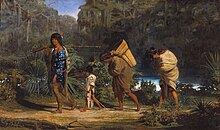
Back Choctaw Afrikaans تشوكتاو Arabic Чакта Byelorussian Чокто Bulgarian Choctaws Catalan Chahta CHO Siocto Welsh Choctaw Danish Choctaw (Volk) German Ĉoktaoj Esperanto
Chahta | |
|---|---|
 Louisiana Indians Walking Along a Bayou Alfred Boisseau – 1847 | |
| Total population | |
| Approximately 214,884 total
212,000 (Nation of Oklahoma 2023)[1] 284 (Jena Band 2011)[2] 11,000 (Mississippi Band 2020)[3] | |
| Regions with significant populations | |
| United States (Oklahoma, Mississippi, Louisiana) | |
| Languages | |
| American English, Choctaw | |
| Religion | |
| Protestant, Roman Catholic, traditional beliefs | |
| Related ethnic groups | |
| Chickasaw, Muscogee, Natichez, Alabama, Koasati, and Seminole |
| People | Chahta |
|---|---|
| Language | Chahta anumpa, Hand Talk |
| Country | Chahta Yakni |
The Choctaw (Choctaw: Chahta) are a Native American people originally based in the Southeastern Woodlands, in what is now Alabama and Mississippi. Their Choctaw language is a Western Muskogean language. Today, Choctaw people are enrolled in three federally recognized tribes: the Choctaw Nation of Oklahoma, Mississippi Band of Choctaw Indians, and Jena Band of Choctaw Indians in Louisiana.[4]
The Choctaw were first noted by Europeans in French written records of 1675.[5] Their mother mound is Nanih Waiya, a great earthwork platform mound located in central-east Mississippi. Early Spanish explorers of the mid-16th century in the Southeast encountered ancestral Mississippian culture villages and chiefs.[6]
The Choctaw coalesced as a people in the 17th century and developed at least three distinct political and geographical divisions: eastern, western, and southern. These different groups sometimes created distinct, independent alliances with nearby European powers. These included the French, based on the Gulf Coast and in Louisiana; the English of the Southeast, and the Spanish of Florida and Louisiana during the colonial era.
Most Choctaw allied with the Americans during the American Revolution, War of 1812, and the Red Stick War, most notably at the Battle of New Orleans. European Americans considered the Choctaw to be one of the "Five Civilized Tribes" of the Southeast. The Choctaw and the United States agreed to a total of nine treaties. By the last three, the US gained vast land cessions in the Southeast. As part of Indian Removal, despite not having waged war against the United States, the majority of Choctaw were forcibly relocated to Indian Territory from 1831 to 1833.[7][8] The Choctaw government in Indian Territory had three districts, each with its own chief, who together with the town chiefs sat on their National Council.
Those Choctaw who chose to stay in the state of Mississippi were considered state and U.S. citizens; they were one of the first major non-European ethnic groups to be granted citizenship.[9][10][11] Article 14 in the 1830 treaty with the Choctaw stated Choctaws may wish to become citizens of the United States under the 14th Article of the Treaty of Dancing Rabbit Creek on all of the combined lands which were consolidated under Article I from all previous treaties between the United States and the Choctaw.[12]
During the American Civil War, the Choctaw in both Indian Territory and Mississippi mostly sided with the Confederate States of America. Under the late 19th-century Dawes Act and Curtis Acts, the US federal government broke up tribal land holdings and dissolved tribal governments in Indian Territory in order to extinguish Indian land claims before admission of Oklahoma as a state in 1907. From that period, for several decades the US Bureau of Indian Affairs appointed chiefs of the Choctaw and other tribes in the former Indian Territory.
During World War I, Choctaw soldiers served in the US military as some of the first Native American codetalkers, using the Choctaw language. Since the Indian Reorganization Act of 1934, the Choctaw people in three areas have reconstituted their governments and gained federal recognition. The largest are the Choctaw Nation in Oklahoma.
Since the 20th century, the Mississippi Band of Choctaw Indians were federally recognized in 1945,[13] the Choctaw Nation of Oklahoma in 1971,[14] and the Jena Band of Choctaw Indians in 1995.[15]
- ^ "Choctaw Nation of Oklahoma | Choctaw Nation". www.choctawnation.com.
- ^ "Jena Band of the Choctaw Tribe". 64 Parishes.
- ^ "Mississippi Band of Choctaw Indians".
- ^ "Indian Entities Recognized by and Eligible To Receive Services From the United States Bureau of Indian Affairs". Federal Register. US Department of the Interior. January 29, 2021. pp. 7554–58. Retrieved 20 October 2021.
- ^ Galloway and Kidwell, "Choctaw in the East, 511
- ^ Walter, Williams (1979). "Southeastern Indians before Removal, Prehistory, Contact, Decline". Southeastern Indians: Since the Removal Era. Athens, Georgia: University of Georgia Press. pp. 7–10.
- ^ Zinn, Howard (2003). "As Long as Grass Grows or Water Runs". A People's History of the United States: 1492–Present. HarperCollins. p. 126. ISBN 0-06-052842-7.
- ^ PBS (2007). "Andrew Jackson: Good, Evil & the Presidency". PBS. Retrieved 25 August 2009.
- ^ Kappler, Charles (1904). "INDIAN AFFAIRS: LAWS AND TREATIES Vol. II, Treaties". Government Printing Office. Archived from the original on 17 May 2008. Retrieved 19 February 2008.
- ^ Baird, David (1973). "The Choctaws Meet the Americans, 1783 to 1843". The Choctaw People. United States: Indian Tribal Series. p. 36. LCCN 73-80708.
- ^ Council of Indian Nations (2005). "History & Culture, Citizenship Act – 1924". Council of Indian Nations. Retrieved 2 May 2008.
- ^ Treaty of Dancing Rabbit Creek September 30th 1830 ratified on February 24th 1831 (7 Stat. 333)
- ^ "Mississippi Band of Choctaw Indians". Office of Environmental Management. Florida Department of Transportation. Retrieved 20 October 2021.
- ^ Encyclopedia of Oklahoma History and Culture. "Malmaison, Palace in a Wilderness, Home of General LeFlore". Archived from the original on 9 July 2008. Retrieved 8 September 2008.
- ^ "Jena Band of the Choctaw Tribe". 64 Parishes. Retrieved 20 October 2021.
© MMXXIII Rich X Search. We shall prevail. All rights reserved. Rich X Search